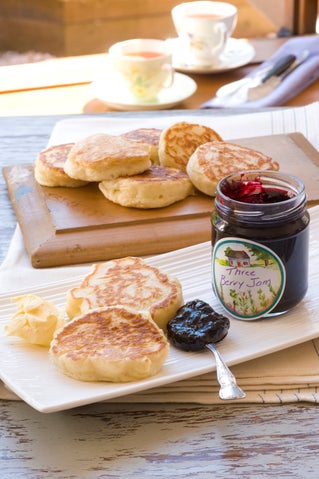
Berry jams are the easiest jams for novice preserve cooks to attempt as they set well. Jams are best enjoyed within the year after making.
Ingredients
- 500 grams fresh or frozen mixed berries (raspberries, blueberries, boysenberries)
- 500 grams sugar
Method
- If using fresh fruit, pick over the fruit and make sure there are no berries that show signs of mould. Rinse and shake off excess moisture, only if necessary. Omit this step if using frozen berries.
- Place the fruit in a small preserving pan or large saucepan and place over a moderate heat. Mash the fruit with a potato masher until it is pulpy. Bring to the boil.
- Gradually pour the sugar into the boiling fruit, stirring constantly as you add the sugar. Continue stirring until the sugar has dissolved.
- Bring to the boil and boil rapidly for 10 minutes or until a setting point is reached (see tips). Stir occasionally during this process.
- Turn the heat off, skim away any scum that rises and allow the bubbles to subside.
- Bottle into hot sterilised jars. Leave the hot jars on a chopping board, away from young children, and covered loosely with a clean dry tea towel. Seal when cold. Store in a cool, dry place away from damp and direct light.
Cooks Tips
- The recipe can be doubled. - For a single berry jam, use this recipe, making sure you have equal quantities by weight of fruit and sugar. Use raspberries, boysenberries, blueberries or blackberries but do not use strawberries, they have little or no pectin and will not set by themselves. - Only wash the berries if they are dirty, as berries easily trap or absorb water and this will affect the boiling time and therefore the setting of the jam. - To know when a jam has reached setting point, follow these basic steps: Put a saucer in the fridge once the jam begins to boil. When 10 minutes of boiling time is up, remove the jam from the heat (so it does not continue to boil) and drop half a teaspoonful onto the cold saucer. Stand 30 seconds. Hold the plate to eye level and push the jam with your index finger. If you see wrinkles in the surface, the jam is ready to be bottled. If the jam is not ready, return to the boil and test again after 5 minutes' additional cooking time.



 10 minutes
10 minutes 30 minutes
30 minutes Makes 3x 350-gram jars
Makes 3x 350-gram jars
Comments (0)
Please login to submit a comment.